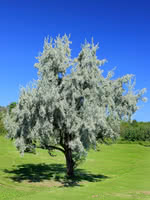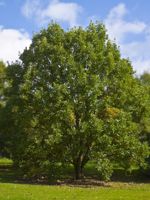Mon-Fri 9am - 5pm Mountain time
Russian Olive vs Schuettes Oak
Elaeagnus angustifolia
Quercus × schuettei (Quercus bicolor × Quercus macrocarpa)
NOT AVAILABLE THIS SEASON - MIGHT RETURN
Russian Olive is a medium-sized deciduous tree that has attractive silvery coloured foliage with small yellow flowers that emit a fragrant sweet smell.
It is drought and salt tolerant, and works well as a shelterbelt species. Russian Olive can also be used to combat erosion.
Note: although Russian Olive is planted as an attractive boulevard tree in many northern areas, in warmer areas it can invade watersheds and is considered invasive. Please do some research and plant the right tree in the right place.
Schuettes Oak is a naturally occurring hybrid of Swamp White Oak and Bur Oak. With a faster growth than both parent species, it is one of the fastest growing Oak trees. They are known for growing very large and wide, so space them appropriately. It is considered one of the most adaptable Oaks with little preference on soil conditions. It can handle growing in wet, saturated soils as well as those that are dry, clay, or alkaline.
The Schuettes Oak has very large acorns. They have a large cup portion like the Bur Oak, but without the fringe. Due to the Swamp White Oak parentage, the acorns have less tannins and a sweeter taste. They are a food source for various wildlife including birds, squirrels, and deer.
Russian Olive Quick Facts
Schuettes Oak Quick Facts
Toxicity: when injested, can be toxic for many animals
In row spacing: 1.8 - 2.4 m (6 - 8 ft)

